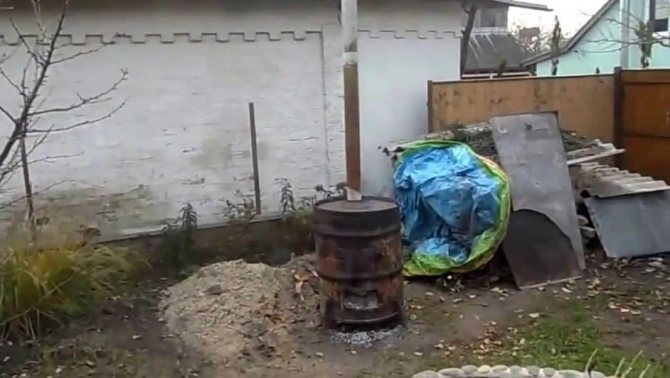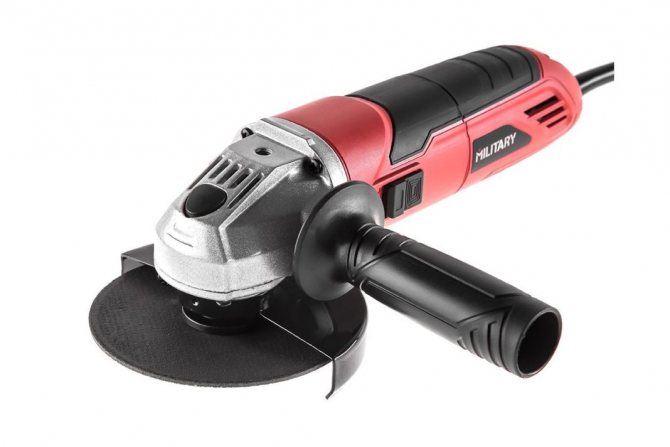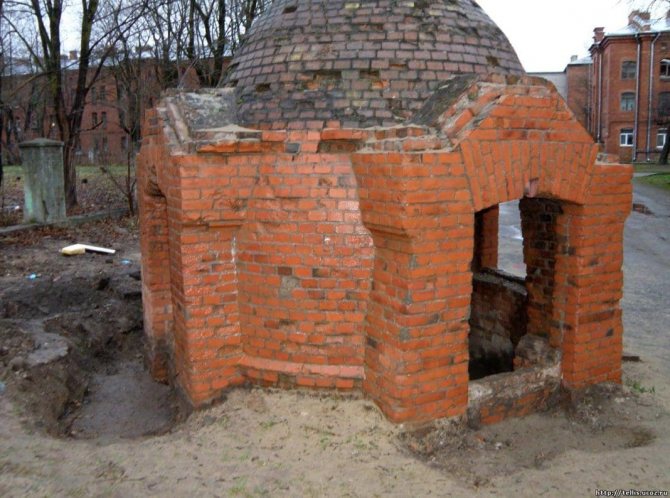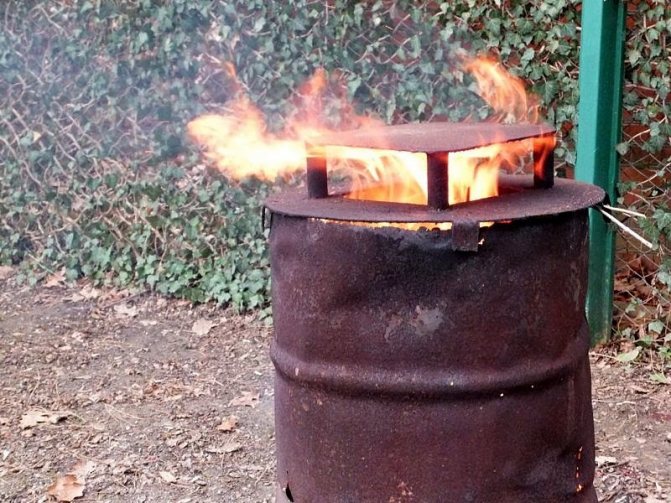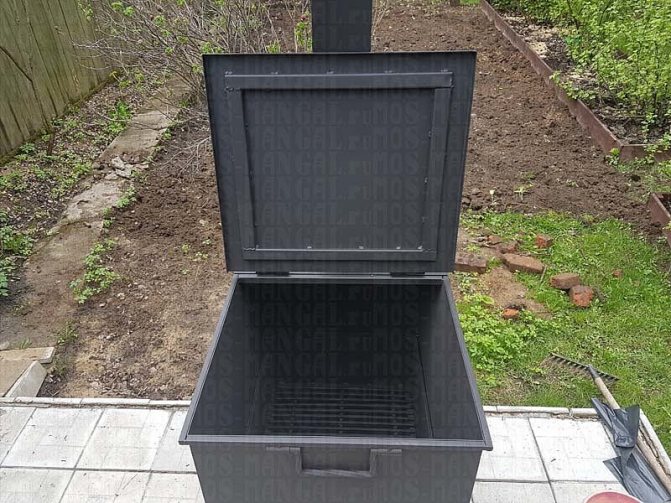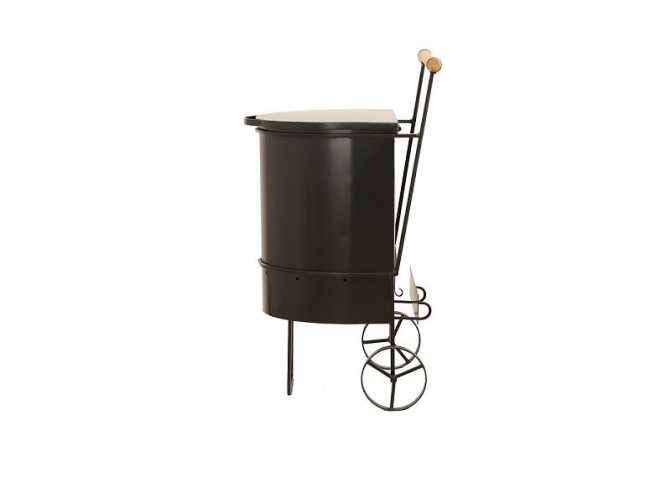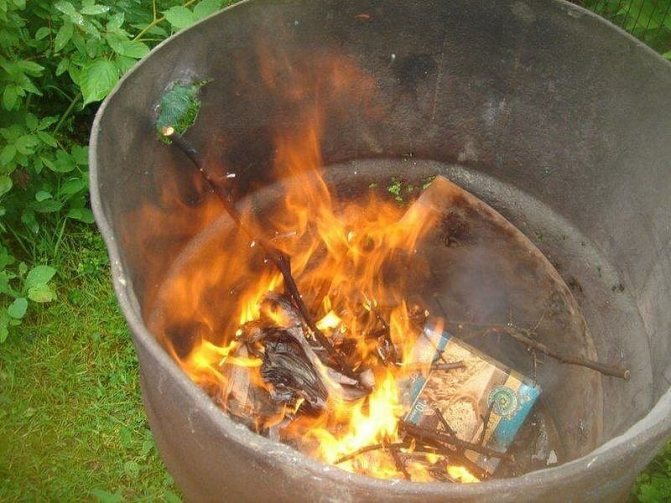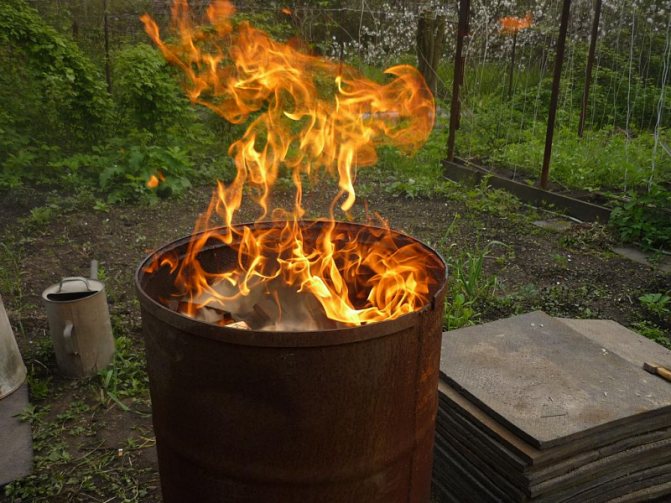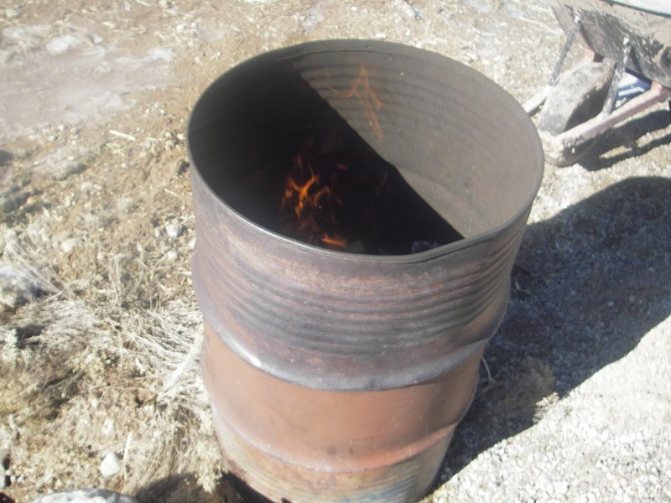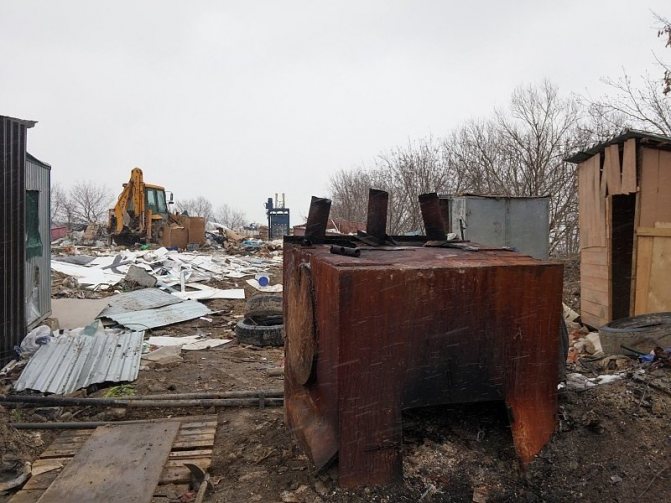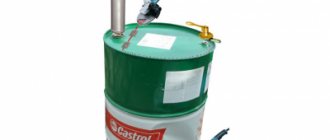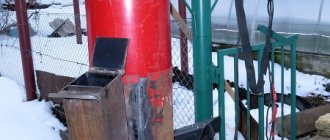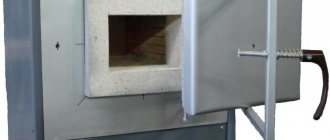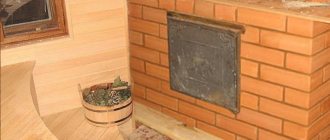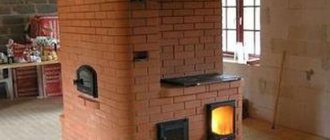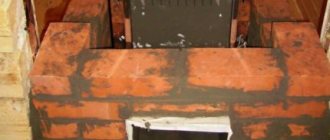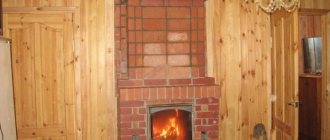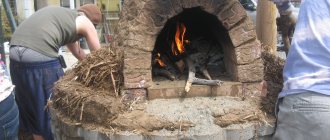21.11.2015
As you know, the main problem of any suburban area is garbage. It is quite expensive to take it out, so summer residents often resort to a more economical option - burning. But lighting fires is an unsafe occupation, it is much better to carry out this "operation" in special containers. They are sold in specialized stores, but if you wish, you can make a garbage oven for your summer cottage with your own hands.
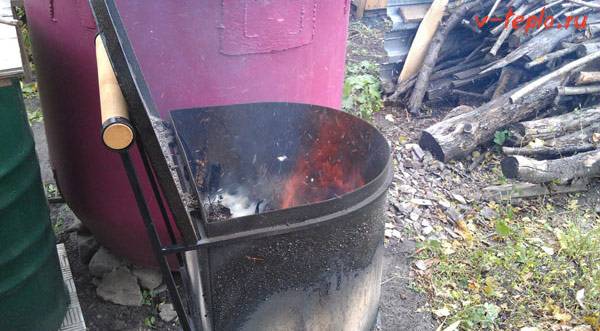
There are several options, let's take a closer look at each of them.
Method one. Upgraded barrel
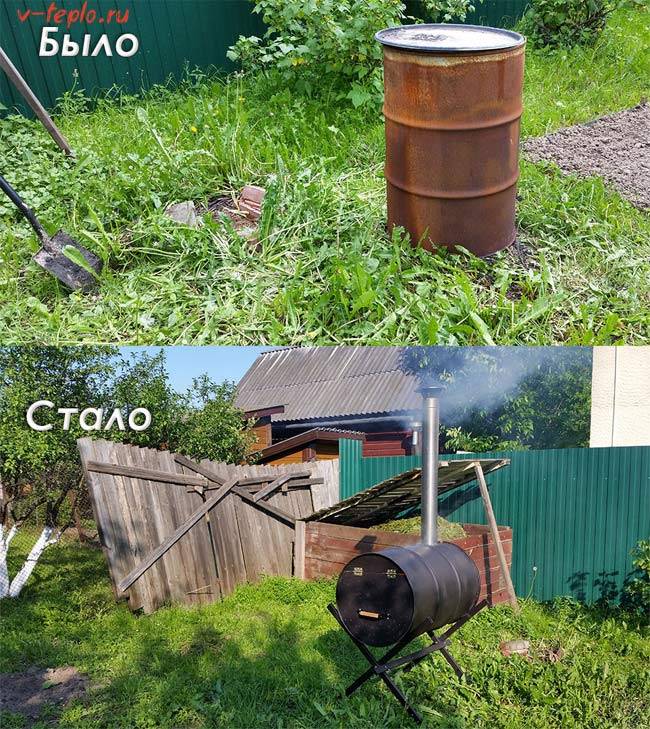

Agree, the options described above using a metal barrel are hardly able to decorate your site. Therefore, you can do it differently.
First, you need a diagram of the future design, we make it up It will look something like this.
Preparatory activities
As for the materials, more of them will be required than in any of the methods already known to us. So, in addition to the barrel, you need to prepare:
- 5-meter metal profile (we will cut it into five equal lengths);
- 5 meter steel bar;
- a pair of loops;
- 1 m2 of welded mesh;
- spark arrestor (the diameter of its fasteners should be 11.5 centimeters);
- 200 grams of wire;
- 1.5-meter tin pipe with a diameter of 11.5 centimeters;
- degreaser;
- a handle on which a wooden nozzle is worn;
- bolts - 6 pieces, the same number of nuts;
- electric jigsaw, metal files for it;
- 20 self-tapping screws with wide caps;
- drill for metal with a diameter of 1.2 centimeters;
- grinder, circles to it - emery and for metal;
- the Bulgarian herself;
- refractory paint;
- brushes (as an option - we can use a spray);
- electric drill;
- jigsaw.
Having prepared everything you need, we begin to build a garbage oven for the country house with our own hands.
The working process
- We cut out the door. To do this, draw a straight line at the bottom to which this door will be attached. We cut along the line with a grinder, while making every effort not to touch the side walls.
- We make a hole in one of the corners of the cut. It is important that it is located close to the side wall of the structure and directly on the cut line. From this point we will move with a jigsaw.
- We insert the jigsaw saw into the hole and carefully cut the bottom of the barrel. At the same time, we do not touch the upper part of it. We move as close as possible to the edges of the barrel. A grinder for this, of course, will not work - only a jigsaw.
- We make several holes in the door through which air will flow. We make them at the bottom, in any order.
- If necessary, we clean the barrel of paint or rust using a grinder with an emery disc.
- We build the goats. For this we use five pieces of a metal profile. The trestles will consist of a pair of crosspieces connected by a rod. We connect the profile strictly at an angle of 90 degrees, for which we make a pair of holes in each of them and tighten them with bolts.
- We degrease and paint the barrel, do not forget about the elements of the goats. It is advisable to carry out these procedures in a disassembled state. We paint all the elements in several layers, after each layer we wait for the paint to dry completely.
- We collect the goats. We proceed to this a day after painting. Be sure to put washers under the nuts, securely tighten all structural elements. The resulting strength is quite enough for the barrel and the additional weight, which is debris.
- Install hinges and handles. For this we use a screwdriver and self-tapping screws with wide caps.
- We form a hole for the chimney. Draw a circle with a diameter of 11.5 centimeters at the top of the barrel
- We equip our garbage stove at the dacha with our own hands with a chimney. Install it on the "petals" so that they are inside. After that, in several places we screw the pipe to the “petals” with self-tapping screws so that it does not come off.
- We mount the grate. We do everything as shown in the image below.
- Installing the cover. We fasten it with clamps, although we can resort to such a self-made construction of bolts.
Then we cut this circle with a grinder into a kind of "petals". We should have about ten segments. We bend the "petals" up so that they are positioned vertically.
As a result, we got such a design. That's it, the trash stove is ready, you can start using it!
Method two. We use a metal barrel
An old waste barrel can be an ideal option for incinerating trash. Having carried out some simple manipulations with it, you will receive a container in which you can safely dispose of all accumulated garbage. Of course, craftsmen have come up with a lot of options for converting a barrel into a stove, but we will consider only a few - the most effective and simple to perform.
"Bottomless" waste disposal barrel
A fairly simple option that does not require much effort or a lot of tools. From the equipment in this case, you only need a hammer, a chisel, an electric drill and a bayonet shovel. The algorithm of actions should be as follows.
Step one. First, we take an old iron barrel and, using a chisel (if possible, this can be done with a grinder), remove its bottom.
Step two. Next, we take a drill and make a couple of holes in the bottom of the barrel. They are necessary in order to provide good traction when burning debris.
Step three. After that, we arm ourselves with a shovel and dig a small oblong hole (its length should be about 100 centimeters, width - 20 centimeters, and the depth should correspond to the height of the shovel bayonet).
Step four. Before starting to incinerate garbage, we kindle a small fire in the pit (we use dry branches and paper for this), and on top we install a barrel without a bottom, but in such a way that the air from the pit freely penetrates into the holes made earlier.
Step five. Garbage can now be placed inside the barrel. We do this gradually, if long branches come across, then it is not at all necessary to saw them - with proper traction, they will soon turn into ash.
Video - Country garbage disposal
There are other ways, let's look at them as well.
Barrel on bricks
This do-it-yourself garbage oven at the dacha is done as follows.
Step one. We take a thick-walled barrel and make a large number of holes in its bottom. After that, we drill the same holes in the lower part of the container, approximately 1/2 of its height.
Step two. Then we prepare the brick base (such as in the image), not forgetting about the gaps between the bricks, which are necessary for the normal flow of air.
Step three. We install the leaky barrel on the prepared base, put debris in it and light the fire.
Video - Garden oven for waste disposal
Method three. We use an old heater for waste disposal
If you have an old sauna stove lying around, then do not rush to send it to the landfill. Even if it is badly rotten or rusted. A stove, which has long become unusable, we can turn into a fairly good waste disposal unit by installing it in our summer cottage. We do it as follows. First, using the tools at hand, we remove all internal elements from the heater - we only leave the grate and, of course, the body itself.
After that, we take sheet steel and weld it to the base from the inside, thus strengthening the entire structure.
In this case, we will be able to load garbage directly from above, although before loading large items, it is recommended to ignite the flame in advance with the help of dry branches and paper. Directly during the combustion process, it is advisable to cover the furnace with an iron sheet, placing pieces of brick under it - this will ensure the unhindered exit of flue gases.
Method four. Waste disposal brick stove
Let's make a reservation right away that a capital structure made of bricks will last an order of magnitude longer than the metal waste disposers described above. And yes, and its aesthetic indicators are at a fairly high level, because such a stove will be an excellent decoration for any suburban area. With average volumes of garbage, a smaller and smaller structure will be required (only 115 bricks are needed), although if necessary, we can increase its dimensions. The procedure in this case is shown below.
Step one. First, we clear an area with dimensions of 1x0.7 meters, after which we fill it with sand (the layer thickness should be at least 5 centimeters).
Step two. We lay the first layer of bricks around the perimeter of the future structure. We do not use the solution for this, but put it "dry". It is important that there is a slight gap between the bricks (at least 1.5 centimeters) in order to ensure good traction. In total, the first layer will require eight bricks: one on the right and on the left, three each at the top and bottom.
Step three. After that, we lay down a metal grate (you can use reinforcing rods instead), which we welded in advance from a thick wire. If we talk about our specific design with its dimensions, then it needs a lattice of 3 transverse rods and 14 longitudinal ones. At the same stage, you need to take care of the ash pan. There are several options here:
- lay out a brick ash pan;
- pour it out of concrete;
- made of sheet steel.
Which option will be chosen does not play a special role, so we will not dwell on this issue.
Step four. We continue to build a garbage oven at the dacha with our own hands. For the next row, we also need eight bricks, but here we are already observing the dressing, so we already put two units on the sides. In the same way, we lay all subsequent rows, and we do not use the solution, as at first. We perform the last, twelfth row in a continuous one. We install an iron cover on top of it.
Video - Burning garbage correctly
Brick furnace construction
The brick structure will last much longer. In addition, it will not in any way spoil the appearance of the suburban area. For an oversized furnace, 115 bricks are required, but if you want to increase the size of the furnace, there will be no difficulties. The construction procedure is not complicated:
- clearing the area where the furnace will be built. A place with a size of 70 x 100 cm is ideal. A clean and level area should be covered with dry sand, at least 6 cm thick;
- laying the first row of the oven. This stage is very important, as it is necessary to create conditions for traction. This can be done as follows: the brick is laid along the perimeter of the structure at a distance of at least 15 mm, one from one. You do not need to use the solution;
- installation of a steel grating. Such an element is very easy to weld using metal rods. The grate is placed on the first row of bricks;
- the second row should be laid with a bandage;
- the subsequent glad fit, like the first, but in a checkerboard pattern.
According to this principle, you can lay out an oven of any shape and size. The made element of the garden plot can become its addition, one has only to approach the work with imagination.
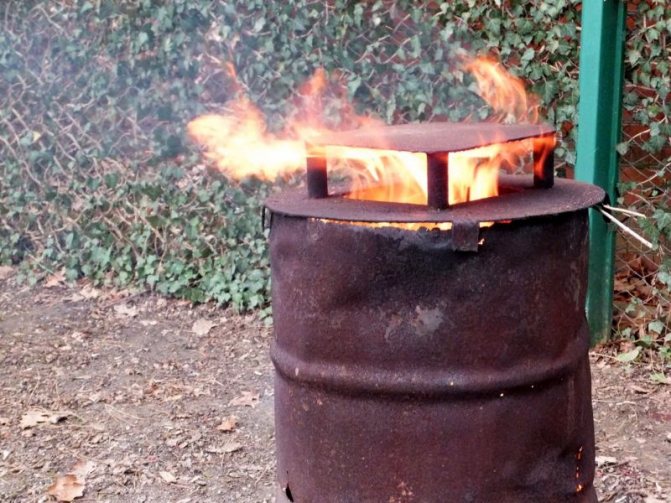

Safety regulations
Incineration of waste is hardly a safe pastime, as there may be trees, bushes or wooden buildings on the site.If there is a strong wind, the sparks can scatter and cause a fire. In a word, when burning garbage, it is imperative to adhere to safety requirements.
Regardless of how high-quality your oven is, always be there when it is working. Do not burn garbage if it is hot or windy outside. Place a container filled with sand or water next to the stove.
If you follow all these requirements, you can get rid of the accumulated garbage as safely as possible for yourself and those around you.
As a conclusion. Factory stoves
If you do not want to make a garbage oven for your summer cottage with your own hands, then you can purchase a ready-made version. Such designs will differ in that, in addition to the elements known to us, they are also equipped with a box for collecting ash.
They can be rectangular and round in shape. For the manufacture of the case, durable steel is used, it is also covered with refractory enamel. But we are talking about simple containers, and there are also more complex designs on sale. So, for example, you can buy one of the multifunctional models with which you can also heat water.
Finally, install and use such equipment only in accordance with safety regulations!
v-teplo.ru
When another waste incinerator burned out, I decided to do something more durable. At first there was an idea to weld a metal stove, but then I decided to use the bricks that remained after laying the fireplace. I decided to make the lining of an ordinary thin-walled metal barrel with bricks. So let's start with the foundation. He marked the pit 75x75 cm. I chose soil on the bayonet of the shovel and covered the pit with gravel. Made the formwork. Then I covered everything with old polyethylene and cast a slab of concrete. I reinforced everything with the remnants of a masonry mesh. While the concrete hardened, it turned to bricks. Each brick was turned to give a trapezoidal shape. I still have a few fireclay bricks and red oven bricks. I decided to make the lowest row of fireclay, and two upper ones from red. I used an iron barrel lid as a template. We start laying the stove. First, lay out the row without mortar. I used chamotte clay as a solution. It took only half a bag. I added a little sand, as did the stove-makers who put me a fireplace and a sauna stove. The first row is laid. It turned out that he was mistaken with the size of the furnace door. We spread the second row. And then the third last row. The grate decided to weld from a metal bar and reinforcement 10 mm. To be continued.
www.forumhouse.ru
Safety measures and recommendations for incineration of garbage in ovens
Safety requirements are very important when it comes to fire. If the barrel for burning garbage in the country is homemade and not closed from above, then the flame can easily spread to nearby trees or bushes, and sparks can fly in all directions and set fire to grass or wooden buildings on the site.
Therefore, the following safety precautions must be observed:
- Incinerators should be located on a separate piece of land, cleared of other objects, dry grass and leaves by at least 10 meters.
- Bushes and deciduous trees should not grow closer than 15 meters, conifers - no closer than 50 meters. The minimum distance to wooden buildings is 25 meters.
- You cannot burn solid waste in the heat, during a strong wind or drought.
- In the immediate vicinity of the incinerator, there must be fire-fighting agents such as sand, fire extinguisher or water. All flammable objects, fuel and ignition fluids must be removed at least 10 meters away.
- A fire kindled in the firebox must not be left unattended.Important: children and animals must not be allowed close to the utilizer for their own safety.
What is the essence of the problem
In any season, a lot of garbage is generated in the country.In summer - construction and food waste, tops of various vegetables, in autumn - leaves and branches after pruning, in spring - the "results" of general cleaning of the site. Perhaps only in winter there is a slight lull, and mainly food waste is flying into the trash can.
Important: The law of the Moscow region (a similar situation in other regions) of November 29, 2005 N 249/2005-OZ prohibited from burning trash, foliage and grass even on your own site! You should not get carried away with this process, especially without a closed oven and in front of unfriendly neighbors, since they only need to call the district police officer, the fire service, or simply fix the smoke on the camera and take the evidence to the appropriate authorities.
There is no ideal way to "work" with waste. Everyone chooses what is convenient for him. But, I think, no one seeks to litter the surrounding forests and arrange ugly spontaneous dumps near the villages. Therefore, many gardeners burn garbage. After all, you can burn everything, from dry twigs to plastic bottles and films from the greenhouse (it is still better to throw them in the trash, since burning plastic does not emit anything useful) - and you do not need to carry it far.
And now, when the essence of the problem is clear, let's try to figure out what is the best way to burn garbage and what safety precautions must be followed in order not to harm ourselves, neighbors, or the environment.
Types of incinerators
You've probably seen how an old refrigerator, barrel, stove or bucket is used as an incinerator. Some craftsmen even build a homemade hearth. What's better? There is no definite answer. Therefore, I will give several ways. For them, various devices are used: from homemade to store.
Iron barrel
Perhaps the most popular option. At any cottage there is an iron barrel into which water is collected for irrigation. Over time, the container ages, rusts, becomes leaky and cannot perform its main function.
Such a barrel can be put under the hearth for incineration.
Such a not quite dilapidated barrel can be made a hearth for burning garbage. It has both pros and cons.
Pros:
- Mobility (everyone can move the barrel to the right place on the site);
- Lack of open fire (compared to a conventional fire);
- Fire control (if necessary, it can be extinguished immediately).
Minuses:
- From constant exposure to high temperatures, the barrel will gradually become unusable, and it will have to be replaced;
- If not properly positioned and used, it can be as dangerous as an open fire.
How to turn a barrel into an oven?
It all depends on whether it is with a bottom or without. A barrel without a bottom is placed on the ground, and a barrel with a bottom is placed on bricks. Now in more detail.
a) We turn a barrel without a bottom into an oven:
- We remove the bottom. The old "residents" of the country shed do not have it anyway. Or it’s so rotten that there’s no problem. If the barrel is new, then you will have to work with a grinder.
- We make holes at the bottom. They are needed for traction. They can be easily done with a drill or chisel.
- Digging a hole. For fire safety, which will be discussed separately a little later, the barrel must be placed in a pit. Its length is about 1 m, and its width and depth are one shovel bayonet (about 30-40 cm).
- We make a fire in the pit. Naturally, at this stage it should be small.
- Installing the barrel.
- We put garbage in portions.
- Thanks to good traction, boards, branches and other waste will burn easily, leaving you with a bunch of useful ash.
Thanks to the good air draft coming from the holes, boards, branches, etc. will burn easily
b) We turn a barrel with a bottom into an oven
With this option, on the one hand, everything is a little easier (no need to knock out the bottom and dig a hole), and on the other hand, it is more difficult (to build a brick base, drill holes in the bottom, etc.). So:
- We drill or punch holes in the bottom of the barrel.
- Create a thrust at the bottom of the barrel (same as in the case of the "bottomless").
- We build a brick base. Be sure to take into account the required distance for air intake.
- We put the barrel on the bricks.
- We light the fire and put the trash
By the way, if you don't like the dull monochromatic color of the barrel, you can change it to a more fun one with the help of heat-resistant paints and imagination. Then the barrel will not only do its job, but also please the eye.
Incinerator
A major incinerator is another decent option.
Incinerator
Of course, it is less popular because it takes longer to build. And a branded oven from a store is more expensive.
Homemade incinerator
Most gardeners adapt a sauna stove for waste disposal. In second place is the old stove-potbelly stove (in which you can't burn much, but for pieces of paper, newspapers, wood chips and other trifles - that's it). In third place is the 115 bricks oven.
It is not for nothing that a brick oven is called 115 bricks, because that is how much you need to build it.
Let us dwell in more detail on the stove and the brick stove, since everything is clear with the potbelly stove. It is enough to transfer it to the right place, and you can start burning. And here sauna stove - a very interesting specimen. If it is no longer useful in the bath, do not rush to turn it into trash. It is not so difficult to convert it and turn it into a utilizer:
- We remove the internal parts, as a result, only the body and the grill remain.
- We make the body more durable by welding sheet metal to it from the inside.
- We make a fire, load garbage from above and cover the structure with a sheet of metal so that there is no open flame. Air draft will be provided by a stone placed under this sheet.
Brick oven no wonder they call "115 bricks", because that is how many pieces you need to build it. This is a standard, one might say, classic size, but if desired, it can be increased. It is very difficult to describe how "115 bricks" is created in one article, since no one can explain the laying process better than a professional or someone who has ever laid a stove with his own hands. One thing I can say for sure: this is a time-consuming process, but the result is worth it. Neat brick beauties-stoves will not spoil the appearance of the site. And an ignorant person may not even guess about their true purpose.
Signature incinerators
Sometimes they are also called waste incinerators. Branded incinerator. Photo from catalog2b.ru
Stove manufacturers unanimously claim that such stoves are convenient, functional and aesthetic. This is confirmed by summer residents. If we compare ready-made ovens with barrels or homemade options, then the advantages of the former are obvious. There is no need to tinker and invent anything: you buy, install and use. Some manage to not only burn garbage in them, but also heat water or cook dinner if the stove is equipped with a stove on top, and wood is burned inside, not polyethylene.
A conventional incinerator has two "floors": a combustion chamber and an ash pan. The improved kit will also have a chimney or the above-mentioned stove. In terms of appearance, there are round, square or barrel-like ovens - with or without a handle and wheels. The body is made of steel, coated with fire-resistant enamel. The volume varies: there are smaller or larger ovens, for 160 liters. Prices also vary: from 6 to 15 thousand rubles.
The design of any furnace isolates waste, protects against sparks and allows ash to be collected without problems.
Waste incinerator in the country: design features, ready-made and homemade option
How to choose the best equipment, buy a ready-made oven or make one yourself, read the article.
At the dacha, waste disposal can be a real problem. The way out of this situation will be to use a stove.You can buy it or do it yourself. Both options have their pros and cons. To burn garbage safely, you need to choose the right design for your hearth. We have deeply studied this topic and are ready to share with our readers what kind of stoves for summer cottages exist, and how to choose them correctly.
What kind of garbage can you burn on your site?
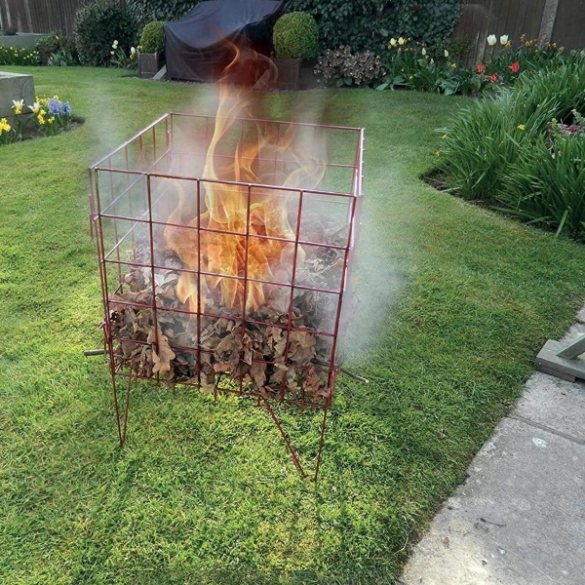

Various debris accumulates in summer cottages. In most cases, you can dispose of it yourself. Waste is burned, freeing up space on the site. But only the following garbage can be disposed of in this way:
- dry grass;
- paper;
- boards;
- branches and trunks of trees;
- rags;
- weeds;
- food waste;
- paper, cardboard packaging for food, drinks;
- old tops.
Such garbage can be safely sent to the firebox. But there is a list of waste that cannot be burned in a furnace. These include:
- plastic;
- glass;
- electronics;
- metal;
- synthetic fabrics;
- aerosol cans;
- painted boards (except for water-based coatings);
- posters, paper with dense ink filling;
- Chipboard;
- other materials, items containing chemical components.
This waste releases toxins when burned or is not disposed of in the same way. They are sent to special recycling centers.
Therefore, before sending the garbage to the firebox, it is sorted. If there is waste prohibited for such disposal, they are taken to a place designated for recycling.
Homemade or ready-made firebox?
There are arguments for and against both options. Homemade designs are much cheaper than ready-made ones. They are simple in design for easy maintenance. But there are also disadvantages. For example, it is impossible to create a complex, high-quality device at home. Primitive equipment can only burn garbage. It cannot perform other functions.
To make a structure for the disposal of summer cottage waste, you need to be able to use a welding machine. The foreman must have the appropriate tool as well as the necessary materials. Thin-walled metal is not suitable for these purposes, and it is difficult to make a high-quality weld in thick metal using a household welding inverter.
Purchased products cost more, but their design is more functional. The heat generated by the equipment can be used to heat the house or to cook food. It is durable and has good build quality. You do not need to have a welding machine on hand and be able to weld metal sheets. Therefore, for many summer residents, it is much easier to buy a hearth.
The appearance of purchased models is better. Many of them have smoke filtration systems that reduce the amount of harmful emissions into the atmosphere.
Purchased models
The finished stove consists of a metal body that prevents sparks from escaping during combustion. It is manufactured from sheet metal with a minimum thickness of 3 mm. The body is covered with heat-resistant enamel to prevent corrosion. The dimensions of the finished models are relatively small. When cold, it can be easily carried from place to place or loaded into the trunk of a car.
There are grate bars inside the firebox. They look like gratings, most often made of cast iron. The combustion process takes place on the grates. Large debris remains here until it becomes ash. The grates are also needed to supply oxygen to support the combustion process.
There is a blower door at the bottom. When it is slightly open, air enters the firebox, intensifying the combustion process. Subsequently, you can scoop up the ash from here and use it as fertilizer.
The top cover will protect the fire from rain and bad weather. It limits the flame, preventing sparks from flying up or flying to the sides. The structure can be vertically loaded with waste. In this case, the firebox door will not be on the body, but on the lid.
Additional elements
Today, many ready-made designs are produced with special additional components. They improve the performance of the equipment by complementing it with a number of functions. For example, complex structures can have a chimney. It increases traction, so garbage is burned faster and better. The chimney design is productive, so it is bought if you need to burn large volumes of garbage. Even in wet weather, the recycling process will be fast.
Another possible additional element may be the presence of a water heater in the design. The liquid is supplied through pipes that pass inside the furnace using a pump. Such a boiler is connected to radiators, using it in the cold season. These are volumetric stoves designed to burn not only garbage, but also firewood and coal.
Equipment with a boiler is used for a small country house. The disadvantage of such a system is the need to constantly throw garbage or firewood into the firebox. They burn out in 3-4 hours, and then you need to load solid fuel again. Fill the heating system with special antifreeze so that in the event of a boiler shutdown, the coolant does not freeze and damage the pipes.
Some designs include smoke purification filters. The oven will be safe for the environment.
Some owners purchase designs with a burner on top. In the process of burning household waste, it will be possible to cook food, heat water. If the country house has a summer kitchen, a model with a burner (or even 2 burners) will be the preferred option.
Homemade construction
To make a stove yourself, you need to prepare the necessary materials and tools. The easiest way to do this is to use a metal barrel. A container that is not rusty will do. Its capacity is 200 liters.
You can also use a pipe section with a diameter of 500 mm. Such a metal case has thick walls from 8 mm, so it is difficult to cut holes and weld seams in this case. A stove made from such a pipe weighs a lot, it is difficult to operate it. The advantage of a thick-walled structure is its durability. The metal will not burn out even with intensive burning of garbage.
You can use a rectangular container as a blank. Loading can be done side or top.
Barrel oven: option no. 1
A barrel is suitable, in which there may even be leaks. The door is cut out at the end. To do this, you need to cut it in a circle. Further, the hinges and the handle are screwed to the segment. At the opposite end, you need to make holes through which air will flow into the firebox.
The oven must be installed on stands. For this, metal corners are used, which are fixed in the form of a parallelepiped or crosswise.
A grate must be inserted inside the structure. You need to leave a little space under it. This will be an ash pan. In the upper part of the barrel, you need to make a hole of the same diameter as the chimney. It is necessary to divide the circle into 10 equal sectors, make cuts along the lines. Then the resulting triangles are folded up. A chimney is welded to them.
Barrel oven: option no. 2
You can use a barrel as a furnace in a different way. You cannot burn garbage in it by simply dumping it into a container. Air will not flow to the lower layers. Because of this, it is impossible to dispose of large volumes of waste.
To solve this problem, holes are made in the bottom of the barrel. They need to be made both in the bottom and along the perimeter of the walls. The barrel cannot be left on the ground. Therefore, a homemade stove must be placed on bricks. They are folded in the form of a firebox, which will allow you to kindle a fire under the barrel, and not in it. So it will be possible to quickly dispose of all the garbage accumulated on the site.
Some safety tips
- Garbage should be burned as far as possible from buildings, dry vegetation and combustible materials.
- Do not leave the hearth unattended.
- Do not get carried away with burning plastic and polyethylene: combustion products give off toxic substances.
- Do not burn garbage in dry, hot or windy weather.
- There should be a "kit" for extinguishing a fire - sand and water - near the hearth.
- Do not place the hearth on dry grass, boards or other flammable materials.
- The access of animals and small children to the hearth should be limited.
Burning should be carried out as far as possible from buildings, dry vegetation and combustible materials
The basic incinerators that are used by the majority, we have considered. But maybe you have some unusual solutions of your own that you want to share with your readers?
7dach.ru
Why make a waste incinerator?
Incineration is the most efficient way to dispose of plant waste for owners of private houses and land.
Note! According to the law, natural waste cannot be thrown into containers for general use intended for solid domestic waste (solid household waste), but must be stored in a compost pit or box on the site. But over time, as it grows, the compost heap can take up too much space.
You can burn unnecessary things in several ways:
- at the stake;
- in a suitable metal container, such as a garden barrel;
- in a special oven.
Of course, the least environmentally friendly and safest way is to make open fires. After all, gusts of wind can spread sparks and a burning mass to the sides, which can cause a fire. In addition, the scorched and burnt earth under the ashes becomes "dead" for a long time.
From this point of view, putting garbage for incineration in an iron container is the safest, but it also has a number of disadvantages:
- used containers with sufficiently thin walls quickly burn out and become unusable;
- due to the lack of traction, the compressed mass of waste remains untouched by the fire at the bottom;
- flying sparks and burning pieces can also cause a fire.
So, with the burning of garbage, the owner of the house is trapped by various dirty tricks.
Important! In order to comply with fire safety, Russian legislation prohibits burning waste both in the city and in the country, and on a suburban area (in an open area or in a barrel, trash can, container). Violators face a fine from 2,000 (for individuals) to 200,000 rubles (for legal entities).
An acceptable solution is the incineration of waste in a special furnace, made in accordance with all fire safety requirements. Also in the country you can burn garbage in a barrel.
Waste incinerator for summer cottages
+7 (916) 301-31-51
Home »Catalog» Waste incinerators
Garbage disposal - on a suburban area creates a problem for many owners. Removing waste is an expensive pleasure, so most summer residents prefer the traditional way to get rid of unnecessary trash - incineration. Making fires is unsafe and impractical; burning waste in special containers is much more efficient. A ready-made garbage stove for the country can be purchased in our store.
There are different types of ovens for your attention:
Stationary incinerators,
Waste incinerators made of metal with a thickness of 2 mm and 3 mm,
Waste incinerators, mobile,
Collapsible garden ovens,
Open and closed combustion incinerators.
What are the types of incinerators. Pros and cons
Typical waste incinerators are usually made of steel. Additionally, the metal is covered with a special enamel that is resistant to high temperatures.
Usually stationary structures are more spacious, but a more mobile portable version can also be purchased.
Stationary models are usually more bulky and heavy, but they can dispose of a large volume at a time or burn large debris (long branches, boards, etc.).
If you need to burn a large amount of waste, you will have to load the portable stove many times, and grind large pieces, but it will easily fit in the trunk of your car and can be easily carried from place to place by one person.
At the bottom of the furnace there is a special grate - a grate, which simultaneously allows air to enter, holds the burning mass and subsequently ensures the loss of burnt ash.
In addition to these points, it is worth paying attention to the following parameters:
- The thickness of the metal must be at least 2 mm. The thicker the steel used, the longer the service life of the unit will be. Thin metal will burn out quickly enough.
- The most convenient structures to use are those that provide for special holes and doors for cleaning ash.
- The garden waste incinerator must be completely fireproof. The penetration of sparks, fire or the fallout of coals into the air is absolutely unacceptable.
- The top cover not only limits the release of fire, but also protects the contents from possible precipitation.
- In models with a chimney, combustion is faster due to increased draft.
Today, more complex designs can be purchased, for example, a model that combines a waste incinerator and a heating boiler for domestic needs. This oven is additionally equipped with a water heater and a water pump. The undoubted advantage of this model is that it is "water purification" of harmful combustion products, that is, it is more environmentally friendly.
Homemade constructions
The simplest smokeless waste incinerator is made from a metal barrel (the desired wall thickness is from 2 mm). A 200 liter container is suitable, not too rusty to ensure a long product life. An alternative option is a pipe segment with a diameter of 500 mm or more. They have thick (from 8 mm) walls, which increases the mass of the structure and makes it more difficult to make holes. Although the system is stronger and more durable. To work with any workpiece you will need:
- drill or screwdriver;
- grinder - for removing the bottom or cutting large holes in it;
- metal rods or ready-made lattice;
- welding machine (optional);
- bricks or other material for the frame.
It will be enough to dig a hole (in terms of the diameter of the structure and a depth of 20-30 cm) above which, on the legs of bricks or other objects, the firebox will be located. For better traction, holes with a diameter of 25 mm are made at the bottom of the body and above the stiffeners.
The garden oven can also be made in the form of a rectangular box. The combustion compartment is located at the bottom (side loading). For the manufacture of such a structure you will need:
- blueprints;
- sheet steel, from 2 mm thick (replaced by a rectangular tank if available);
- metal corners;
- welding machine;
- cutting tools.
A ready-made container is the best solution. But in this case, you will need welding equipment to fasten the hinges of the lid, chimney and other components. Making a hearth from scratch will take longer than turning a tank into a furnace. First, steel parts are cut to the specified dimensions, depending on the planned volume of waste incinerated and the area of the selected area - some sellers offer to perform this procedure for the client. The places of future connections are cleared. For additional strength, the corners are fixed from the inside. All seams can be reinforced with them, but 4 elements at the joints of the sides are enough.
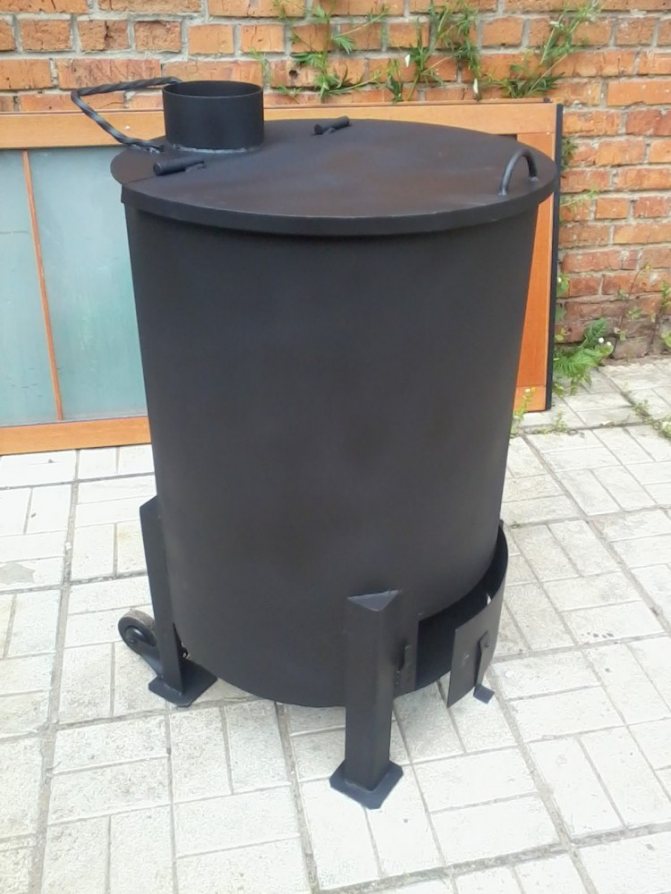

For a chimney, if provided, it is convenient to take a metal pipe of round, square or rectangular cross-section. The size is calculated based on the parameters of the furnace, but for a small furnace, a channel with a bore diameter of 80-100 mm is suitable.It is possible to cover the chimney with thermal insulation and equipped with a spark filter.
The generated energy is suitable for cooking or heating food. Do not barbecue over coals from garbage. But its heat from an iron barrel is good for heating water; warm liquid is a necessary condition for dissolving a number of fertilizers and poisons. A large saucepan will fit well into the hole without blocking the draft due to the perforation of the hearth body. The upper plane of the rectangular heat exchanger will turn into a full-fledged hob.
We make a country stove for burning garbage with our own hands
The simplest and therefore the most common ways to build a garbage oven with your own hands is to use a garden metal barrel for its manufacture or lay it out of bricks.
Garden barrel oven
The procedure for manufacturing such a device for incinerating summer cottage waste is quite simple for any craftsman:
- A door is cut out at the end of the barrel. To do this, first, a neat straight cut of the bottom of the barrel is made with a grinder. It is important not to touch the edges. To cut the lid further, a hole is made from which the lid is carefully cut out with a jigsaw. Next, we drill the holes in the door that are necessary for air to enter.
- If you are using an old barrel, then it must be cleaned of rust and old paint.
- We build trestles to accommodate the future stove. For this, you can use, for example, a metal profile. Before fastening the parts, they must first be painted with refractory paint.
- We also paint the barrel. We are waiting for all the components of the future structure to dry to the end.
- We attach the door to the hinges. We mount the handle.
- In the upper part of the structure we make a hole for the chimney. We install a chimney - a tin pipe about one and a half meters long.
- It remains to place the grate at the bottom of the unit.
And the convenient and fireproof waste incinerator is ready!
Additional information on the manufacture of a vertical design stove from a garden barrel in the video materials: instructions, principle of operation, possibilities of use.
Brick Waste Incinerator
A masonry stove for disposal of waste is also not difficult to design. First you need to choose a permanent place to place it on the site. You will need a piece of land about 70 by 100 centimeters in size. To make a base for a future structure out of it, it is covered with a 5-7 cm layer of sand and laid out with bricks.
Then follow the next steps:
- The first row of bricks is laid without mortar. To create traction, small gaps (about one and a half centimeters) are left between the stones. One brick is missing - this is the door through which you will rake ash in the future.
- Steel grate - the grate is placed on the first row of bricks. For its manufacture, for example, welded reinforcement rods are suitable.
- The next glad - even - fits "with a bandage" (staggered).
- Thus, by alternating even and odd rows, the "heater" can be made 10-12 brick rows high.
- For safety, the structure is closed from above with a metal cover.
"Craftsmen" also often adapt large iron flasks for the manufacture of country stoves: they are already equipped with convenient lids, it remains to mount a chimney, drill holes for draft and install a grate.
It can be easily converted into a stove and an old sauna heater. For "transformation" all unnecessary details are removed from it, leaving only the body and grate.
The main thing to remember when making or buying your stove is that in the first place it is you who can suffer from any non-compliance with fire protection techniques. It must be made as reliably as possible, "conscientiously".Then cleaning your site from plant waste will be easy and not burdensome for you, and most importantly - absolutely safe.
vtorothody.ru
Instructions for making a stove with your own hands
It is quite easy to make a garden oven for burning garbage with your own hands. It all depends on the material chosen. There are utilizers from pipes or barrels, brick or converted old stone furnaces for a bath.
Horizontal stove from a barrel with a pipe
If there is an old barrel on the territory of the site, it is not necessary to throw it away, but it can be smartly adapted for burning garbage and left in the country.
Below is a step-by-step diagram of how to make a horizontal waste incineration barrel with a chimney yourself.
1. Using a grinder, cut the door at the end, making a cut parallel to the barrel border. It is necessary to retreat from the edge 5-10 mm. The door is hinged, a metal handle with a wooden insert is attached to it, as the metal will heat up.
2. Assemble the trestles from the steel profile. This requires five meter sections. Four of them are connected in pairs crosswise at right angles. The fifth segment is a rod connecting the two crosses to each other.
3. Make holes in the bottom and on the end faces for air supply, make cuts on the upper plane of the barrel for further installation of the chimney. To do this, you need to draw a circle of the same diameter as the chimney, divide it into sectors and cut it with a grinder. Bend the resulting "petals" upward, later the chimney will be welded to them.
4. Clean the barrel of rye with a grinder with an emery disc and paint it and the goats in several layers. Place the barrel on the trestle.
5. Make a chimney from a metal pipe 1-1.5 m long and 10-15 cm in diameter. The presence of a chimney increases the intensity of the combustion process.
6. Place a grate made of reinforcing rods or thick wire inside. The remaining space at the bottom will be used as an ash compartment.
7. Install the cover. All is ready.
Upright barrel stove
Old barrels can be easily converted into a firebox for burning garbage in the country. Even if the barrel has been used to collect rainwater and is partially rusted, it is still usable. A vertical waste incinerator is a very simple design that can also be made by hand.
To do this, you will need the barrel itself, several bricks and a grid for the grate.
1. Both barrel bottoms are removed. Solid waste will be loaded from above, and air draft will go from below.
2. Holes are drilled on the sides at the bottom for oxygen supply.
3. A site is being prepared for the installation of a heat exchanger; bricks are laid on it in the form of a firebox.
4. In the barrel at the selected depth, a mesh is laid on the self-tapping screws screwed in at the same level.
5. If necessary, the barrel is painted on the outside in several layers.
6. A cover is installed on top or a metal sheet is simply placed.
The service life of such a furnace depends on the thickness of the metal and the amount of corrosion.
Brick stove
It is possible to build a brick oven for burning garbage in the country with your own hands. It will not only look beautiful, but will also last much longer than the metal versions of utilizers.
About 120-150 bricks will be used to build a medium-sized incinerator. A large brick waste incinerator will have at least 200 elements. It is possible not to use a bonding mortar - the oven will not disintegrate without it - or use a refractory mortar.
The table shows data on what types of bricks can be used to build a solid waste disposal unit and what temperature they can withstand.
| Brick type | Maximum exposure temperature, ℃ |
| Red corpulent | 1000 |
| Fireclay made of refractory clay | 1500 |
| Graphite | 1700 |
Stages of building a brick oven:
1. Clean the area and make a 5 cm thick sand pillow.
2.Lay the bricks in one row around the perimeter, leaving gaps of 1-1.5 cm.
3. Install a sheet metal tray for collecting ash. It is good if a handle is welded to the sheet for convenience.
4. Lay out another row of bricks with gaps.
5. Place a grate made of reinforcing bars or a strong, purchased fine mesh, on which debris will lie.
6. Lay out the remaining rows, using refractory mortar if desired.
7. Install a metal cover on top or leave the heat exchanger without a cover, but then you will have to cover it with a metal sheet.
Using an old sauna heater
A faulty sauna heater will make an excellent stove for burning wood and garden waste.
It is necessary to remove the internal elements from the sauna stove. Only the body and the grate should remain. From the inside, a steel sheet must be welded to the base to strengthen the future utilizer.
Bricks are placed under the stove for the flow of oxygen, and the solid waste is placed into it from above. When the flame flares up, the firebox must be closed with a sheet of metal.
Typical waste incinerators
They are made of steel with a thickness of 2 mm, covered with refractory enamel. Small dimensions, which makes it easy to transport the stove in a passenger car. The combustion process takes place on the grate grate, which retains large debris and household waste, and also does not impede the flow of air from the lower part of the furnace.
Ash itself falls through the bars of the grate. Combustion is regulated by opening / closing the blower door through which oxygen is supplied. From there, ash is scooped up, which gardeners love to use as fertilizer for the site. There is a cover on top that not only protects the flame from rain, but also serves as a limiter.
Stove boiler
Such stoves, in addition to burning waste at the site, are also used as a heating boiler. The stove is equipped with a water heater, as well as a steam vacuum pump that serves to supply water directly to the house.
The smoke is cleaned in the furnace, which allows us to call it environmentally friendly, since in the chimney the combustion products are bound by water. A stove filled with saw cut, unnecessary rags and other waste is enough to heat the house for 24 hours. A special boiler stove will help clean the area and reduce fuel costs.
Design options
Waste and garbage incinerators are classified according to different criteria:
1. By type of manufacture:
- Purchased
- Homemade
2. By type of installation:
- Portable
Portable options are convenient for their mobility and lightness, but most often they are small, which is inconvenient when burning large objects. In this case, you have to grind and crush the waste. But for occasional waste disposal, mobile stoves are ideal, and because of their small size and weight, they can be transported in a car.
- Stationary
Stationary stoves are usually more spacious, but they cannot be moved, and a separate site is needed for the installation or construction of such a structure.
3. By material:
- Steel
- Iron
- Brick
4. By type of construction:
- Rocket
These incinerators are cylindrical in shape with a loading flap located on the side or top. Loading from above is convenient in that bulky waste does not need to be crushed beforehand, but can be placed in the oven as a whole.
There is an opening for ash removal at the bottom, and a cover at the top, which prevents the spread of flames and the ingress of rain or other precipitation. The chimney and holes in the lower part of the structure create additional draft, which is why the fire burns more intensely.
- Tower
Such structures are usually built from bricks. They are easy and inexpensive to build on your own. A brick country oven has one drawback - it is stationary and takes up a lot of space. Therefore, for its installation, it is necessary to prepare and clear a separate piece of land.
- Horizontal
For horizontal home-made waste incinerators in the country, old metal barrels are often used, lying sideways on supports. A chimney is used as a chimney.
- Stoves combined with a boiler
Such furnaces are installed in small country houses, when it is expensive or impractical to install a heating boiler. The problem with this design is that every time it is necessary to heat the house, it is necessary to kindle garbage, which may not have time to accumulate at such a rate. Also, the system must be filled with antifreeze, and not water, so that in winter the pipes do not freeze and do not burst.

